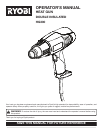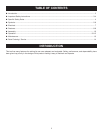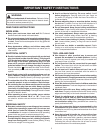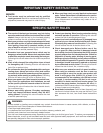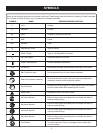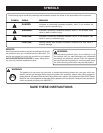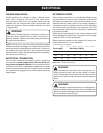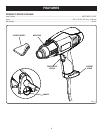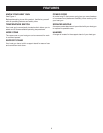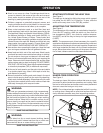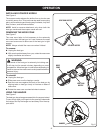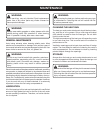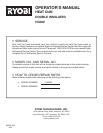
4 5
SERVICE
n Tool service must be performed only by qualified
repair personnel. Service or maintenance performed by
unqualified personnel may result in a risk of injury.
n When servicing a tool, use only identical replacement
parts. Follow instructions in the Maintenance section
of this manual. Use of unauthorized parts or failure to
follow Maintenance Instructions may create a risk of
shock or injury.
IMPORTANT SAFETY INSTRUCTIONS
SPECIFIC SAFETY RULES
n The nozzle of the heat gun becomes very hot during
operation and should not be touched until the tool has
cooled. Always hold the tool by the insulated gripping
surface to reduce the risk of serious personal injury.
n Heat guns produce very high temperatures and must
be used with caution to prevent combustible material
from igniting. Keep tool in constant motion; do not
stop or dwell in one spot. Following this rule will reduce
the risk of fire or serious personal injury.
n Excessive heat can generate fumes which may be
dangerous when inhaled. Wear a dust respirator mask
or dual filter respirator mask when using the heat gun.
Following this rule will reduce the risk of serious personal
injury.
n Keep a fully charged fire extinguisher close at hand
for emergency use. Following this rule will reduce the
risk of fire or serious injury.
n Do not leave the heat gun unattended while running or
cooling down. Always set tool on a flat, level surface
so nozzle tip is directed upwards, away from support-
ing surface, while running or cooling down. Following
this rule will reduce the risk of fire or serious injury.
n Know your power tool. Read operator’s manual care-
fully. Learn its applications and limitations, as well
as the specific potential hazards related to this tool.
Following this rule will reduce the risk of electric shock,
fire, or serious injury.
n Always wear safety glasses. Everyday eyeglasses
have only impact-resistant lenses; they are NOT
safety glasses. Following this rule will reduce the risk
of serious personal injury.
n Protect your hearing. Wear hearing protection during
extended periods of operation. Following this rule will
reduce the risk of serious personal injury.
n Inspect tool cords periodically and, if damaged, have
repaired at your nearest Authorized Service Center.
Constantly stay aware of cord location. Following this
rule will reduce the risk of electric shock or fire.
n Check damaged parts. Before further use of the
tool, a guard or other part that is damaged should
be carefully checked to determine that it will operate
properly and perform its intended function. Check for
alignment of moving parts, binding of moving parts,
breakage of parts, mounting, and any other conditions
that may affect its operation. A guard or other part that
is damaged should be properly repaired or replaced
by an authorized service center. Following this rule will
reduce the risk of shock, fire, or serious injury.
n Make sure your extension cord is in good condition.
When using an extension cord, be sure to use one
heavy enough to carry the current your product will
draw. A wire gauge size (A.W.G.) of at least 14 is
recommended for an extension cord 50 feet or less
in length. A cord exceeding 100 feet is not recom-
mended. If in doubt, use the next heavier gauge. The
smaller the gauge number, the heavier the cord. An
undersized cord will cause a drop in line voltage resulting
in loss of power and overheating.
n Save these instructions. Refer to them frequently and
use them to instruct others who may use this tool. If you
loan someone this tool, loan them these instructions
also.
WARNING:
Fumes created by heating some materials may contain chemicals known to cause cancer, birth defects, or other
reproductive harm. Some examples of these chemicals are:
• lead from lead-based paints,
• crystalline silica from bricks and cement and other masonry products, and
• arsenic and chromium from chemically-treated lumber.
Your risk from these exposures varies, depending on how often you do this type of work. To reduce your exposure to
these chemicals: work in a well-ventilated area and work with approved safety equipment, such as those masks that
are specially designed to filter out microscopic particles.



